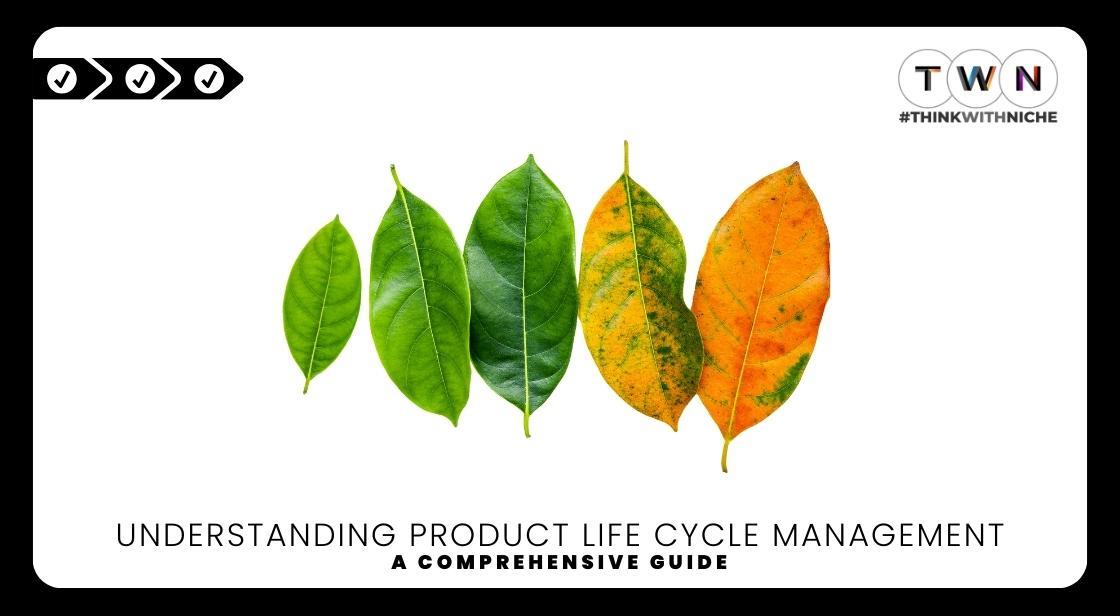Understanding Product Life Cycle Management: A Comprehensive Guide

Blog Post
In today's fast-paced business landscape, where innovation is key and competition is fierce, efficiently managing the life cycles of products has become an imperative for success.
This comprehensive guide, titled "Understanding Product Life Cycle Management," delves deep into the world of Product Life Cycle Management (PLM).
It explores its significance, functioning, and its profound impact on businesses across various industries.
The title of this guide itself, "Understanding Product Life Cycle Management," hints at the vast landscape we are about to navigate. PLM, a strategic approach embraced by organizations worldwide, plays a pivotal role in overseeing a product's entire journey – from its conception and design to manufacturing, distribution, and eventual retirement from the market.
This intricate process requires the harmonious coordination of people, processes, business systems, and information. Its ultimate goal is to ensure efficient product development, adherence to quality standards, and the ability to stay competitive in an ever-evolving market.
In this guide, we will embark on a journey to comprehend the intricacies of Product Life Cycle Management, exploring its essence, its operational stages, and the critical impact it has on businesses operating in diverse sectors.
Let's begin our exploration by defining Product Life Cycle Management and understanding its core principles.
In today's fast-paced business landscape, staying ahead of the competition requires not only innovation but also efficient management of product life cycles. This is where Product Life Cycle Management (PLM) comes into play.
PLM is a holistic approach to managing a product's journey from its conceptualization and design to manufacturing, distribution, and eventual retirement from the market.
In this comprehensive guide, we'll delve into the world of PLM, its importance, how it works, and its impact on businesses across various industries.
Understanding Product Life Cycle Management: A Comprehensive Guide
1. What Is Product Life Cycle Management (PLM)?
Defining PLM: Product Life Cycle Management (PLM) is a systematic and strategic approach used by organizations to manage the entire life cycle of a product, from its initial concept and design through manufacturing, distribution, usage, and ultimately, retirement.
PLM involves the coordination of people, processes, business systems, and information to ensure that products are developed efficiently, meet quality standards, and remain competitive in the market.
The Stages of a Product's Life Cycle:
The life cycle of a product typically consists of several key stages, each with its own characteristics and challenges. These stages are as follows:
-
Introduction: In this initial stage, the product is launched into the market. Sales are usually slow as customers become aware of the new offering. Companies invest heavily in marketing and promotion to create product awareness.
-
Growth: During this phase, sales start to grow rapidly as more customers adopt the product. New players might join the market, resulting in heightened competition. Businesses prioritize the expansion of their production capacity and the growth of their market presence.
-
Maturity: Sales growth stabilizes in the maturity stage. The market becomes saturated, and competition intensifies. Companies may differentiate their products, offer promotions, or explore new markets to maintain sales levels.
-
Decline: In the decline stage, sales begin to decline due to changing customer preferences, technological advancements, or market saturation. Companies may decide to discontinue the product or make minimal investments to prolong its life.
-
End of Life (EOL): Eventually, products reach the end of their life cycle. Companies may phase out production, offer support for existing customers, and plan for product retirement.
PLM encompasses all these stages, with a focus on optimizing product development, reducing time-to-market, ensuring product quality, and making informed decisions at each phase.
It involves using technology and software solutions to manage product data, collaborate across teams, and integrate processes seamlessly.
PLM Process
The PLM process is a holistic approach to managing the lifecycle of a product from conception to disposal. It involves integrating all aspects of the product development process, including engineering, manufacturing, marketing, and sales.
Five stages of the PLM process:
-
Conception: This is the stage where the idea for a new product is generated and developed. This may involve conducting market research, identifying customer needs, and brainstorming ideas. Once an idea has been selected, it is further developed into a concept, which includes a description of the product, its features, and its benefits.
-
Design: This is the stage where the product is designed and engineered. This involves developing technical drawings, specifications, and bills of materials. The design process also includes testing and prototyping to ensure that the product meets all requirements.
-
Manufacturing: This is the stage where the product is manufactured. This involves planning the production process, sourcing materials, and assembling the product. Quality control measures are also implemented to ensure that the product meets all standards.
-
Marketing and sales: This is the stage where the product is marketed and sold to customers. This involves developing marketing campaigns, creating sales materials, and distributing the product to retailers or other sales channels.
-
Service and support: This is the stage where the product is serviced and supported after it has been sold. This may involve providing customer support, warranty repairs, and software updates.
The PLM process is important because it helps businesses to improve the efficiency and effectiveness of their product development process. It also helps to ensure that products meet all customer requirements and are of high quality.
PLM Tools and Technologies
PLM tools and technologies are software solutions that help businesses to manage the product life cycle (PLM) process. PLM tools and technologies can help businesses to:
-
Manage product data: PLM tools and technologies can help businesses to manage all aspects of product data, including product design, engineering, manufacturing, and marketing data. This can help to improve the efficiency of the product development process and to reduce the risk of errors.
-
Collaborate on product development: PLM tools and technologies can help businesses to facilitate collaboration between different teams involved in the product development process. This can help to improve communication and coordination, and to reduce the time it takes to develop new products.
-
Automate product development processes: PLM tools and technologies can help businesses to automate many of the tasks involved in the product development process. This can free up employees to focus on more strategic tasks, and to help improve the efficiency of the product development process.
-
Track and manage product changes: PLM tools and technologies can help businesses to track and manage product changes throughout the PLM process. This can help to ensure that all stakeholders are aware of the changes, and that the changes are implemented correctly.
-
Analyze product performance: PLM tools and technologies can help businesses to analyze product performance data. This data can be used to identify areas for improvement, and to make better decisions about product development and marketing.
Examples of PLM tools and technologies:
-
Product data management (PDM) systems: PDM systems are used to manage product data throughout the PLM process.
-
Product lifecycle management (PLM) software: PLM software is a more comprehensive solution that helps businesses to manage all aspects of the PLM process, including product data, collaboration, automation, and change management.
-
Computer-aided design (CAD) software: CAD software is used to design products.
-
Computer-aided engineering (CAE) software: CAE software is used to analyze and simulate the performance of products.
-
Computer-aided manufacturing (CAM) software: CAM software is used to generate machine tool code for manufacturing products.
PLM tools and technologies can be used by businesses of all sizes, but they are particularly beneficial for large businesses with complex product development processes. PLM tools and technologies can help businesses to improve the efficiency and effectiveness of their product development processes, bring products to market more quickly and cost-effectively, and improve customer satisfaction.
Also Read: Top Business Software for Maximize Business Potential
Importance of PLM in Modern Business
Enhancing product development
PLM can help businesses to enhance product development by providing a central repository for all product data and by facilitating collaboration between different teams involved in the product development process. This can help to improve the efficiency of the product development process and to reduce the risk of errors.
Streamlining processes
PLM can help businesses to streamline their product development processes by automating many of the tasks involved. This can free up employees to focus on more strategic tasks, and to help improve the efficiency of the product development process.
Reducing time-to-market
PLM can help businesses to reduce time-to-market by helping them to streamline their product development processes and to bring products to market more quickly and cost-effectively.
Ensuring compliance and quality
PLM can help businesses to ensure compliance with regulations and standards. It can also help businesses to improve the quality of their products by tracking and managing product changes and by analyzing product performance data.
Facilitating collaboration
PLM can help businesses to facilitate collaboration between different teams involved in the product development process. This can help to improve communication and coordination, and to reduce the time it takes to develop new products.
Here are some specific examples of how PLM can be used to achieve these benefits:
-
Enhancing product development: PLM can be used to create a digital prototype of a product before it is physically built. This can help to identify and fix any potential design flaws early in the development process.
-
Streamlining processes: PLM can be used to automate the process of generating manufacturing instructions from product design data. This has the potential to cut down on time and minimize the chances of mistakes.
-
Reducing time-to-market: PLM can be used to track the progress of product development projects in real time. This can help to identify any potential delays early on and to take steps to mitigate them.
-
Ensuring compliance and quality: PLM can be used to track and manage product changes. This can help to ensure that all changes are made in accordance with regulations and standards. PLM can also be used to analyze product performance data to identify areas for improvement.
-
Facilitating collaboration: PLM can be used to create a central repository for all product data and documentation. This can help to improve communication and coordination between different teams involved in the product development process.
Benefits of Implementing PLM in business
Here are some of the key benefits of using a PLM process:
-
Reduced costs: PLM can help businesses to reduce costs by improving the efficiency of their product development process. For example, PLM can help to reduce the number of product development errors and to streamline the manufacturing process.
-
Improved product quality: PLM can help businesses to improve the quality of their products by ensuring that all aspects of the product development process are well-coordinated. For example, PLM can help to ensure that new products meet all customer requirements and that they are manufacturable to a high standard.
-
Increased customer satisfaction: PLM can help businesses to increase customer satisfaction by ensuring that they are able to bring products to market more quickly and cost-effectively. For example, PLM can help businesses to reduce the time it takes to develop new products and to offer more competitive prices.
-
Reduced environmental impact: PLM can help businesses to reduce their environmental impact by helping them to design and develop more sustainable products. For example, PLM can help businesses to select more environmentally friendly materials and to design products that are easier to recycle.
Real-World Applications of PLM
PLM is used in a wide variety of industries, including:
PLM in Aerospace and defense industry:
PLM is used in the aerospace and defense industry to manage the development of complex products such as aircraft, spacecraft, and missiles. PLM can help to ensure that these products are designed to meet all requirements, that they are manufactured to a high standard, and that they are compliant with all regulations.
PLM in Automotive industry:
PLM is used in the automotive industry to manage the development of complex products such as cars, trucks, and buses. PLM can help to ensure that these products are designed to meet all requirements, that they are manufactured to a high standard, and that they are compliant with all regulations.
PLM in Consumer goods industry:
PLM is used in the consumer goods industry to manage the development of a wide variety of products, such as food and beverage products, personal care products, and household products. PLM can help to ensure that these products are designed to meet all requirements, that they are manufactured to a high standard, and that they are compliant with all regulations.
PLM in Healthcare and pharmaceuticals industry:
PLM is used in the healthcare and pharmaceuticals industry to manage the development of new drugs, medical devices, and diagnostic tests. PLM can help to ensure that these products are safe and effective, and that they are compliant with all regulations.
PLM in Electronics and technology sector:
PLM is used in the electronics and technology sector to manage the development of a wide variety of products, such as computers, smartphones, and other electronic devices. PLM can help to ensure that these products are designed to meet all requirements, that they are manufactured to a high standard, and that they are compliant with all regulations.
Here are some specific examples of how PLM is used in these industries:
-
Aerospace and defense industry: PLM is used to manage the development of the F-35 Joint Strike Fighter, which is one of the most complex aircraft ever built. PLM is also used to manage the development of the Space Launch System, which is the rocket that will be used to launch astronauts to the moon and beyond.
-
Automotive industry: PLM is used to manage the development of the Toyota Camry, which is one of the best-selling cars in the world. PLM is also used to manage the development of the Tesla Model 3, which is one of the most popular electric vehicles on the market.
-
Consumer goods industry: PLM is used to manage the development of the Coca-Cola recipe, which is one of the most closely guarded trade secrets in the world. PLM is also used to manage the development of the Procter & Gamble Pampers diaper, which is one of the most popular diapers in the world.
-
Healthcare and pharmaceuticals industry: PLM is used to manage the development of the Pfizer COVID-19 vaccine, which was one of the first vaccines to be developed and approved for use against COVID-19. PLM is also used to manage the development of the Medtronic heart pump, which is one of the most popular heart pumps on the market.
-
Electronics and technology sector: PLM is used to manage the development of the Apple iPhone, which is one of the most popular smartphones in the world. PLM is also used to manage the development of the Samsung Galaxy smartphone, which is another popular smartphone on the market.
Conclusion: Embracing PLM for Business Excellence
PLM is a powerful tool that can help businesses to improve the efficiency and effectiveness of their product development processes, bring products to market more quickly and cost-effectively, and improve customer satisfaction.
The ongoing evolution of PLM
PLM is a constantly evolving discipline, and new technologies and trends are emerging all the time. Some of the key trends in PLM include:
The rise of digital twins:
Digital twins are virtual representations of physical products and systems. Digital twins can be used to simulate the performance of products and systems before they are physically built or deployed.
This can help businesses to identify and fix potential problems early on, and to improve the overall performance of their products and systems.
The increasing use of artificial intelligence (AI):
AI is being used in PLM to improve the efficiency and effectiveness of a variety of tasks, such as product design, engineering, and manufacturing. For example, AI can be used to automate the generation of design alternatives, to identify potential design flaws, and to optimize manufacturing processes.
The growing importance of collaboration:
Collaboration is becoming increasingly important in PLM as businesses move towards more agile and distributed product development processes. PLM software is being developed to support collaboration between different teams involved in the product development process, such as design, engineering, manufacturing, and marketing teams.
Embrace PLM for competitive advantage
In today's competitive marketplace, businesses need to be able to develop and launch new products quickly and efficiently. PLM can help businesses to do just that.
By embracing PLM, businesses can gain a competitive advantage by improving the quality of their products, reducing costs, shortening time to market, and increasing customer satisfaction.
Tips for embracing PLM for competitive advantage:
-
Start by assessing your current product development process. Identify areas where PLM can help you to improve efficiency and effectiveness.
-
Choose a PLM solution that is right for your business. Consider your specific needs and requirements when choosing a PLM solution.
-
Implement PLM gradually. Don't try to implement PLM across your entire business all at once. Start by implementing it in a pilot area and then expand it to other areas over time.
-
Train your employees on PLM. Make sure that your employees are properly trained on how to use PLM software.
-
Get buy-in from all stakeholders. Make sure that all stakeholders, including management, employees, and customers, are on board with the implementation of PLM.
By following these tips, businesses can embrace PLM and gain a competitive advantage.
You May Like
EDITOR’S CHOICE












